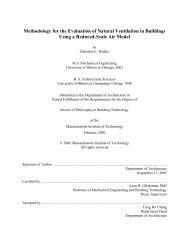CHT-08-012 Runchal_Final_Jun_08 - Cham
CHT-08-012 Runchal_Final_Jun_08 - Cham
CHT-08-012 Runchal_Final_Jun_08 - Cham
Create successful ePaper yourself
Turn your PDF publications into a flip-book with our unique Google optimized e-Paper software.
At one of our subsequent meetings, Brian mentioned that Wolfshtein was reporting success alongsimilar lines and asked us to get together. We soon realized that we were essentially using the sameapproach – just the problems we were working on were different and that we had approached theproblem from different view points – one from a high-Reynolds number and the other from a low-Reynolds number viewpoint. We realized the limitations of the violation of the positive-definitematrix coefficients and the consequent numerical instability for high-Reynolds number flows.Brian then made an analogy with how the wind from the north always brings cold - or that from thepigsty always stinks. I guess Brian knew this because he had grown up close to a pigsty. Thesediscussions led to Brian proposing the “upwind” concept. Brian also made an important physicalanalogy of likening the upwind and FD method to a series of tanks (control volumes) and tubes(grid). Though we did not realize it at the time, this later led to the formalization of the “FiniteVolume” concept. With these two changes we were soon “free” of the Reynolds number constraintand the tank-and-tube analogy changed our approach to thinking in terms of fluxes rather than thestate variables. Once formalized, this eventually frees one from the limitations of the Taylor’sSeries and equating “order” with ‘accuracy”. With these changes we started assembling a “joint”Navier-Stokes solver hammered out of our specific requirements. Like many other codes of that era,this was based on the stream-function and vorticity (ψ-ω) variables.One can see the beginnings of the FD in what Brian was doing with his unified method. Instead ofusing “piece-wise” polynomials to construct a local value to convert the differential equationsdirectly to algebraic equations (as in FD), he was using the “piece-wise” polynomial to represent aset of values (profile) and then integrating the differential equations to obtain the algebraicequations that will give the values of the constants of the profile. But in his characteristic fashionhe used his insight to invent a “physical” rather than a “mathematical” approach to the problem.With his insight, it was easy for him to see that the focus of interest should not be “variables” buttheir “fluxes”. With his engineering background and extensive work on the usefulness of the“control volumes”, he quickly came to view each “node” of a finite difference grid as anindependent “tank” which exchanges “fluxes” with other tanks by “tubes”. Brian’s re-invention ofthe upwind scheme similarly had a “physical” insight into the mathematical approach. Once thefocus is fluxes, upwinding is straightforward: fluxes come from somewhere; they have a distinctspeed and flow in a certain direction.Soon thereafter Brian sent a paper by Barakat and Clark [1965] for my review and we could see thatthey had “upstaged” us on the upwind “discovery”. Also Burgraff [1966] had published his nowclassic paper on square cavity where he reported success at low Re numbers but had failed to obtainsolution beyond Re=400. We thought we should publish our work before we were trumped up byanother claim. In our new-found enthusiasm, we were blissfully ignorant of the pitfalls of upwind.This led to our first papers on finite difference methods with the IC approach [<strong>Runchal</strong>, 1967,<strong>Runchal</strong> and Wolfshtein, 1969]. The second paper is also a good example of why not to publish apaper in a hurry since it contains results for Re=1000 for driven square cavity which were proven tobe wrong. Little did we know that upwind and one-sided differences had been around far longer. Apaper by Courant et al. [1952] had used upwind concept more than a decade earlier andmathematicians had extensively explored the properties of one-sided and central difference methodsfor far longer. However in those days the interaction between mathematicians and engineers wassomewhat limited.Later on we started becoming wise to the pitfalls of upstream differences and this led to some workon “numerical” diffusion. Wolfshtein [1968] published a technical note where he showed that falsenumerical diffusion is related both to the speed of the flow and the angle of the stream-lines to thegrid. Spalding [1972] proposed an exponential method to replace “upwinding” but eventually wesettled on a “hybrid” method [<strong>Runchal</strong>, 1972] that automatically blended the Central and upwinddifference methods based on local Peclet number.-- Page 6 of 19 --
















